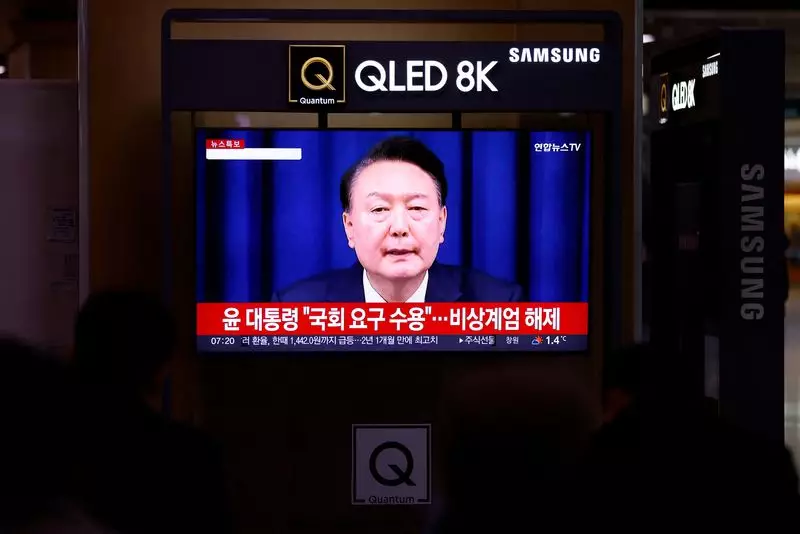The recent political crisis in South Korea reflects a series of unprecedented events that have shaken the confidence of investors and lawmakers alike. The dramatic sequence began when President Yoon Suk Yeol declared martial law, only to reverse his decision within hours. This sudden and confusing move has resulted not only in a notable decline in the South Korean stock market but also a comprehensive discourse regarding the implications for domestic and foreign investments. In this analysis, we will explore the market’s response to this crisis, sentiments expressed by financial experts, and the broader repercussions on the South Korean economy and governance.
Upon the announcement of martial law, South Korean financial markets reacted swiftly. The won hit a two-year low, with investors anxiously reassessing the stability of the country’s economic framework. The benchmark KOSPI index registered a sharp decline, losing nearly 2% on the day following the declaration. Such immediate reactions are largely indicative of investor sentiment that is sensitive to political instability. The political gamble appears to have backfired on the leadership as it has fostered an environment where uncertainty triumphs, which has historically been detrimental to emerging markets like South Korea.
Market participants voiced concerns regarding the so-called “Korea discount,” an elevated risk premium that often accompanies political unrest in the country. The repercussions of this crisis have reinforced investors’ wariness, yielding a reluctance to allocate resources towards South Korean equities and currency, despite the perception that the market is cheap.
Industry experts from various sectors have weighed in on the implications of the current political strife. Portfolio managers like Sat Dhura express a clear hesitance to invest further in the region due to uncertain political climates and the prospect of legislative impeachment. Dhura underscores that the current outlook renders the market less appealing, especially when considering potential shifts in leadership that may ensue in the wake of President Yoon’s decisions.
Additionally, experts note that this situation could exacerbate the “Korean Discount.” Daniel Tan highlights that the KOSPI’s current valuation at 0.8 times its one-year forward estimated book value starkly contrasts with international benchmarks, such as the MSCI World Index, which trades close to three times. This disparity signifies a growing risk premium on Korean assets that investors may require in light of political volatility.
The potential for instability raises questions about the medium- to long-term economic direction for South Korea. Robert Carnell argues that unless governmental bodies and the Bank of Korea introduce strong liquidity measures, the nation could face prolonged investment stagnation. He emphasizes that continued intervention from the central bank may mitigate severe downturns, yet does not fundamentally alter the underlying issues, such as weak domestic demand.
Frances Cheung, meanwhile, points out that, while initial fears prompted a knee-jerk reaction in currency trading, the eventual lifting of martial law has alleviated immediate pressures in international markets. The prevailing thought among experts is that the modification in policies can lead to enough liquidity, helping stabilize the financial landscape. However, there remains wariness about the overarching economic strategies that will follow the current political turmoil.
Looking into the future, analysts like Linda Lam suggest a cautious approach when it comes to investing in emerging markets, including South Korea’s. Lam indicates that domestic political upheavals have historically had fleeting effects on market stability as long as the currency remains stable. However, the looming uncertainties brought about by changing global trade dynamics and political shifts, especially given the impending Trump administration, can complicate the equation, creating tariff and currency challenges that could further impact market conditions.
Meanwhile, David Chao estimates that the current volatility could ultimately be a short-term blip. Yet, he underscores the dynamic nature of the situation, recognizing that the evolving political landscape will likely continue to reverberate throughout not just market conditions but the economic outlook of the entire region.
As South Korea navigates through this high-stakes political crisis, the effects on the market reveal deep-seated vulnerabilities fostering investor anxiety. The reactions to the martial law declaration underscore the fragile interplay between governance and economic confidence in the region. With experts advocating for caution and a shift towards a more discerning investment strategy, the days ahead will be pivotal in shaping the economic and political narrative of South Korea. The trajectory remains unclear, but the ongoing turmoil serves as a stark reminder of the influence that political stability—or instability—can exert on financial markets.

